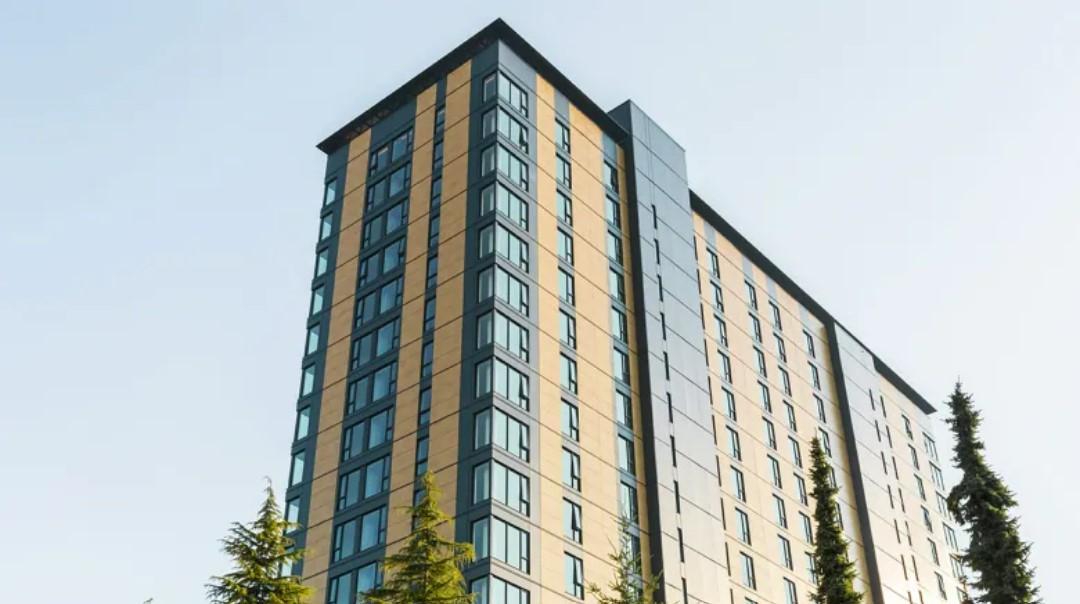Sam Salem and grad student Cory Hubbard developed a method for joining large wooden beams and columns
Researchers at Lakehead University have earned a patent for their contribution to a promising new field of construction.
Engineering professor Sam Salem and graduate student Cory Hubbard developed a mechanism for joining large, engineered timber beams and columns and tested their system for fire resistance.
The innovation will help in the construction of very tall buildings built primarily from engineered wood products instead of concrete and steel.
“It basically depends on just two steel rods,” Salem said of the creation. “So the steel rods is a way of mechanically connecting structural elements together like beams and columns. … the rods are actually embedded inside the timber element. So they are not exposed to fire.”

While wood, unlike steel, is combustible, steel degrades quickly in heat, explained Christian Dagenais, a lead scientist at FP Innovations, the government and industry-funded non-profit that does research and development work for the forest sector.
Significant contribution to mass timber construction
When fully encased in wood, the steel rods are protected from the heat of a fire, Salem said.
Salem’s work is Thunder Bay’s most significant contribution to the field of mass timber construction, Dagenais said.
Those leading Canada’s involvement in the forest bio-economy say it’s an area where the country is poised to excel.
The approach has already been used in more than 700 buildings across Canada that are either completed or in the works, according to the Natural Resources Canada website. Eight of those are at least 13 stories in height.
“[Salem’s] work is really relevant,” Dagenais said. “He’s been doing a lot of research on connections in the past few years and is generating a lot of new information [and] knowledge for designers so that they can design safe timber buildings.”
Salem tested his connection system in Lakehead University’s world-class fire testing and research facility, heating it over the course of an hour to more than 1,000 degrees – the temperature of the fire that brought down the World Trade Centre, according to the U.S. National Institute of Standards and Technology.
He used a relatively small engineered beam, he said.
His next step will be to test a larger beam in an effort to achieve the two-hour fire rating needed for taller buildings.
The fire testing facility at the university is one of many investments made by government and industry in the bio-economy in Thunder Bay.
The city is also home to two pilot bio-refineries at the local Resolute pulp mill, a state-of-the-art bio-refinery lab at Lakehead University, and the Centre for Research and Innovation in the Bio-Economy (CRIBE).
Local researchers have worked tirelessly to turn pulp mill waste into everything from green versions of chemicals used by the mining industry to biodegradable absorbent material for diapers.
The city remains well-positioned to benefit from the sector, according to Warren Mabee, the director of the Queens Institute for Energy and Environmental Policy, because of its proximity to forests, transportation corridors and existing mills.
But Thunder Bay, like the country as a whole, has yet to see major private investment flow from its efforts.
“This is the million dollar question,” Mabee said.
“Why is the bio-economy taking so long to become, you know, a dominant part of local economies, particularly in northern Ontario and other parts of Canada? And I think that the answer really goes back to, ‘What products do we want to get out of that bio economy?'”
‘Bio-economy 2.0’
Early investments in the sector focused on finding plant-based alternatives to fossil fuels, he said, but concerns around cost and sustainability hampered those efforts.
More recently, researchers have focused on replacing other fossil fuel products such as chemicals and plastics with plant-based alternatives.
“It’s almost as though we had a bio-economy 1.0,” Mabee said.
“Now, we’re starting to think about the bio-economy 2.0, which is really more about how can we take existing types of products, whether it’s construction, or packaging products, and move them into the 21st, or even the 22nd century.”
The bio-economy continues to grow every year, Mabee added, even if it has yet to produce a product that captures people’s imaginations and generates loads of investment.
It’s a “slow build,” he said.
Chris Walton, the CEO of CRIBE, confirmed that it is receiving a growing number of inquiries from potential investors asking about what the province has to offer.
For that reason, it established a detailed website about a year ago called ForestEDGE that contains information on the province’s wood supply, its location, its costs and its infrastructure.
“We have over 2,000 users per month,” Walton said.
“And the good news is that a couple of these companies have moved to pre-feasibility studies, and they’re actively taking an interest in investing in Ontario based off the data that we provided.”
The Thunder Bay Community Economic Development Commission has further built on CRIBE’s work by developing its own section on the ForestEDGE website to promote the city.
Project manager Jamie Lee Kostecki said the CEDC is also receiving a growing number of inquiries about the bio-economy.
“We’re seeing a strong interest in progress around renewable fuels like ethanol, bio diesel and renewable natural gas,” she said. “But there’s also strong interest in products that are derived from lignin. So it could be quite vast.”
Source: CBC News
